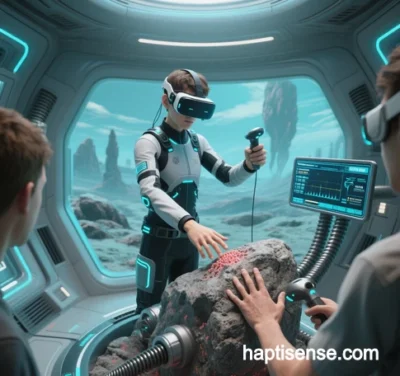
Deep Dive into Haptic Perception (HapticSense) Principles
Haptic perception technology bridges physical interactions and neural processing through multimodal sensing, neural encoding, and closed-loop feedback mechanisms. Its workflow spans four stages: mechanical stimulus detection → signal transduction → neural encoding → cortical integration, integrating biomechanics, materials science, and computational neuroscience. Below is a comprehensive analysis of its technical and biological foundations:
I. Mechanical Stimulus Detection: Synergy of Biological and Artificial Sensors
Haptic perception begins with detecting physical stimuli (pressure, vibration, temperature) via biological receptors and engineered sensors:
- Biological Receptor System
- Mechanoreceptors:
- Merkel cells: Detect static pressure and texture (spatial resolution: 0.5 mm).
- Meissner corpuscles: Sense dynamic touch (e.g., sliding; 10–200 Hz response).
- Pacinian corpuscles: Specialized for high-frequency vibrations (50–1,000 Hz).
- Thermoreceptors: Free nerve endings detect temperature gradients (threshold: 0.1°C) .
- Artificial Sensor Technologies
- Piezoelectric: Converts mechanical strain to charge signals (e.g., PVDF films; sensitivity: 0.01 N).
- Resistive: Measures pressure via conductive elastomers (e.g., CNT/PDMS composites; resolution: 1 kPa).
- Capacitive: Detects contact force via electrode spacing (flexible surfaces; range: 0–50 N).
- Fiber Bragg grating: Quantifies strain via wavelength shifts (immune to EMI; used in surgical robots) .
II. Signal Transduction: From Physics to Neurophysiology
Raw tactile signals are converted into neuro-compatible codes:
- Pulse Frequency Encoding
- Stimulus intensity correlates with pulse frequency (e.g., 50 Hz = “soft,” 100 Hz = “rigid”).
- Case: Bionic gloves encode grip force into 20–150 Hz microcurrents for amputees to distinguish foam vs. metal .
- Spatial Topological Mapping
- High-density sensor arrays (100 points/cm²) mimic fingertip texture perception, mapped to somatosensory cortex (S1) via topology-preserving algorithms.
- Case: Meta’s haptic gloves use 2 mm-resolution capacitive grids to simulate virtual surface roughness .
- Multimodal Fusion
- LSTM models integrate pressure, temperature, and vibration signals to predict tactile scenarios (e.g., grasping hot coffee).
- Case: Tianjin University’s system combines piezoresistive/thermoelectric sensors to distinguish wool (0.5 N/mm²) from sandpaper (2.3 N/mm²) .
III. Neural Encoding: Bio-Artificial Pathway Integration
Tactile signals form closed loops via afferent (sensory) and efferent (feedback) pathways:
- Afferent Pathway (Perception→Brain)
- Signals travel from mechanoreceptors → spinal cord → thalamus → S1 cortex (latency: 20–50 ms).
- Implanted microelectrodes (e.g., Utah arrays) enhance spatial resolution (0.4 mm) for direct S1 recording .
- Efferent Pathway (Brain→Feedback)
- Intracortical microstimulation (ICMS): Activates S1 neurons to mimic natural touch (e.g., prosthetic grip realism) .
- Vibrotactile feedback: Linear resonant actuators (LRAs) generate programmable vibrations (1–300 Hz) for haptic interfaces .
- Closed-Loop Control
- PID algorithms adjust feedback intensity based on EEG/cortical signals to prevent overstimulation.
- Case: University of Pittsburgh’s neuroprosthesis reduces object damage by 78% via real-time grip force modulation .
IV. Cortical Integration: Multisensory Cognition
Haptic perception culminates in embodied cognition through cortical processing:
- Somatotopic Mapping
- Body parts correspond to S1 regions (e.g., fingers occupy 40% of S1 area).
- Multisensory integration in parietal cortex resolves conflicts (e.g., virtual vs. real limb positions) .
- Neuroplasticity and Motor Learning
- Mirror neuron activation: Haptic feedback rewires motor networks (e.g., 35% Fugl-Meyer score improvement in stroke patients) .
- Case: ADHD patients using VR-haptic BCIs doubled attention spans via tactile prompts .
- Hebbian Plasticity
- Repeated stimulation strengthens synaptic connections (e.g., tactile pen training improves Chinese character accuracy by 50%) .
Technical Challenges and Innovations
| Challenge | Limitation | Breakthrough |
|---|---|---|
| Signal Resolution | Non-invasive EEG spatial resolution >5 cm² | High-density ECoG arrays (1,024 channels; 1 mm²) |
| Biocompatibility | 30% annual signal loss in silicon electrodes | Graphene-hydrogel hybrids (18-month stability) |
| Multisensory Conflict | Tactile-visual temporal mismatch | Spiking neural networks (SNNs) mimicking thalamocortical sync |
| Power Efficiency | Implanted systems >10 mW power draw | Wireless RF charging (75% efficiency) + edge computing |
Conclusion
Haptic perception (HapticSense) digitizes the “contact→code→control” loop, enabling breakthroughs in medical rehabilitation (e.g., spinal injury recovery ), human-robot collaboration, and neuroprosthetics. With advancements in miniaturized neural interfaces, multimodal algorithms, and cortical plasticity research, haptic technology is poised to become humanity’s “sixth sense,” redefining sensory boundaries.
Data sourced from public references. For collaborations or domain inquiries, contact: chuanchuan810@gmail.com.
